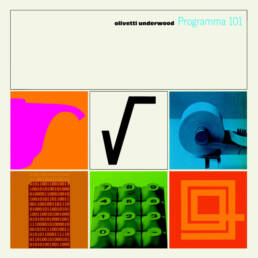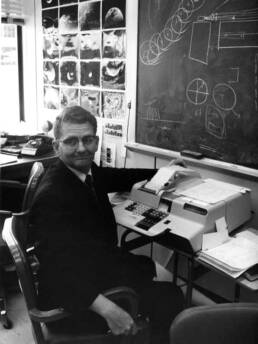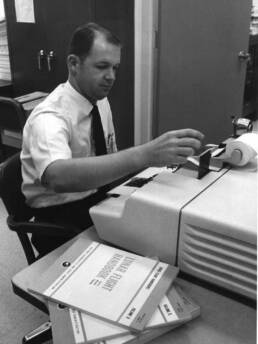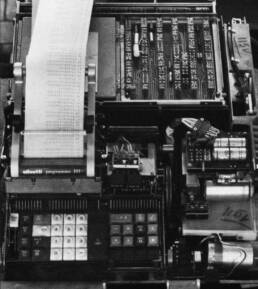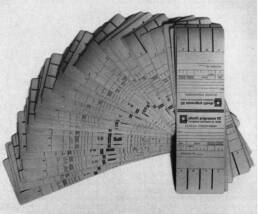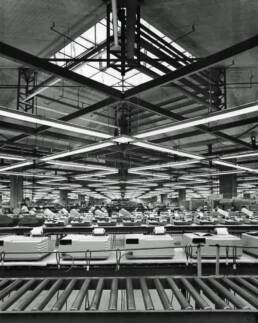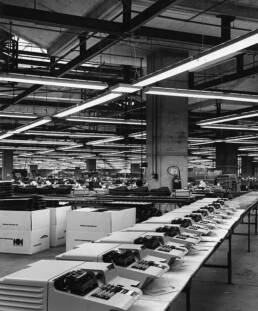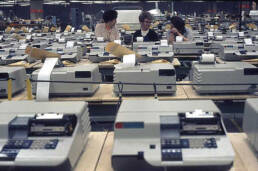By Apollo 11, we had a desktop computer, sort of, kind of, called an Olivetti Programma 101. It was kind of a supercalculator. It was probably a foot and a half square, and about maybe eight inches tall. It would add, subtract, multiply, and divide, but it would remember a sequence of these things, and it would record that sequence on a magnetic card, a magnetic strip that was about a foot long and two inches wide. So you could write a sequence, a programming sequence, and load it in there […].
— David W. Whittle [Apollo 11 mission, Flight Controller, COMM/INST, Vehicle Systems SSR-LM], interviewed by Sandra Johnson on 16 February 2006.
Programma 101 is a milestone in the development of the idea of the personal computer. These images are related to different stages of its history.
Pier Giorgio Perotto came at first at the Laboratorio di Ricerche Elettroniche Olivetti of Barbaricina in Pisa, directed by Mario Tchou. He was working on a machine that bridges the mechanical technology of office machines and the electronic technology of calculators, when Roberto Olivetti asked him in 1962 to study an electronic calculation machine, equipped with the ability to automate the sequence of individual operations with which the various calculations required were made. It should be useful for general users. So, the “Perottina,” later known as Programma 101.
The technical issues – the magnetostrictive line memories, the new silicon technology for the circuit component, a parallel drum printer for the output and, overall, the logical architecture and the interface – were overcome together with the machine’s formal solutions, entrusted to Mario Bellini.
The success after the launch in New York in 1965 exceeds all expectations. The new factory in Harrisburg, Pennsylvania – replacing the old nineteenth-century Underwood plant – was also created for the production of the P101 and the projects that will constitute its evolution. The project was entrusted to Louis Kahn in 1966 and in 1970 the plant became operational, in continuity with the successful use of Programma 101 for the Apollo program. Workplace organization and people’s well-being are the two cornerstones, as it has always been from Ivrea onwards.
This part of the Apollo adventure highlights, once again, the extraordinary nature of Adriano Olivetti’s vision in every sense, as a heritage to be kept constantly in mind.
Contribution curated by Luigi Mandraccio in collaboration with www.storiaolivetti.it – Associazione Archivio Storico Olivetti – Ivrea-Italy, which has generously granted the use of the images.
Reference list
Pisciella, Susanna. 2019. “Olivetti e Ivrea, l’altra faccia della Luna,” Engramma (June 2019). http://www.engramma.it/eOS/index.php?id_articolo=3665
Alle origini del personal computer: l’Olivetti Programma 101. https://www.storiaolivetti.it/articolo/87-alle-origini-del-personal-computer-lolivetti-pr/
Elettronica della Olivetti P101 e dei piccoli sistemi di prima generazione. https://www.storiaolivetti.it/articolo/39-elettronica-della-olivetti-p101-e-dei-piccoli-s/
Pier Giorgio Perotto, quando l’Olivetti inventò il PC. https://www.storiaolivetti.it/articolo/84-pier-giorgio-perotto-quando-lolivetti-invento-i/
Luigi Mandraccio
Architect and Ph.D. student. He pursues intellectual curiosity at the turn of researches and projects – but also as wasting time’s excuse.
On Instagram: @arkigigi

